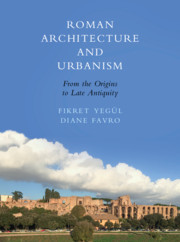Book contents
- Roman Architecture and Urbanism
- Roman Architecture and Urbanism
- Copyright page
- Contents
- Preface and Acknowledgments
- Maps
- Introduction
- 1 Urban Design and Architecture in Rome and Italy during the Republic and the Early Empire
- 2 Temple Architecture of Republican Rome and Italy
- 3 Technology of Building
- 4 Julio-Claudian Architecture in Rome
- 5 Residential Architecture
- 6 Imperial Architecture in Rome from the Flavians through the Antonines
- 7 Architecture and Planning in Italy and the Western Provinces
- 8 Architecture and Planning in North Africa
- 9 Greece under Roman Rule
- 10 Architecture and Planning in Asia Minor
- 11 The Roman Near East
- 12 The Late Empire in Rome and the Provinces
- General Bibliography
- Glossary
- Index
- Plate Section (PDF Only)
- References
4 - Julio-Claudian Architecture in Rome
Published online by Cambridge University Press: 21 August 2019
- Roman Architecture and Urbanism
- Roman Architecture and Urbanism
- Copyright page
- Contents
- Preface and Acknowledgments
- Maps
- Introduction
- 1 Urban Design and Architecture in Rome and Italy during the Republic and the Early Empire
- 2 Temple Architecture of Republican Rome and Italy
- 3 Technology of Building
- 4 Julio-Claudian Architecture in Rome
- 5 Residential Architecture
- 6 Imperial Architecture in Rome from the Flavians through the Antonines
- 7 Architecture and Planning in Italy and the Western Provinces
- 8 Architecture and Planning in North Africa
- 9 Greece under Roman Rule
- 10 Architecture and Planning in Asia Minor
- 11 The Roman Near East
- 12 The Late Empire in Rome and the Provinces
- General Bibliography
- Glossary
- Index
- Plate Section (PDF Only)
- References
Summary
War can be fought on many fronts simultaneously, using weapons on the battlefield and great buildings in cities to attain and project controlling power. In the first century bce, the Republic was challenged and almost brought down by massive pressures for long overdue social and land reforms ignored in order to contain the expanding privileges of the aristocracy; internal and external revolts; and the constantly shifting alliances and rivalries among the talented but ruthless leaders jockeying for power. Facing crises, the state accorded these individual strong men extraordinary powers as war time consuls and generals, a circumscribed practice that enflamed ambition and eventually turned many into dictators with their coterie of supporters and fellow travelers. Few survived the autocratic positions created by their ambitions. In this volatile world, architecture could be used as a weapon of choice to project power and influence. Successful generals advertised their achievements abroad through splendid triumphal ceremonies in Rome and equally splendid buildings that were partially paid for with captured spoils and covered with propagandistic inscriptions and artwork. Each sought to outdo the other, creating a competitive escalation in size, grandeur, and material opulence of buildings. In the mid-first century bce, Julius Caesar allegedly spent 60 million sesterces (five times the annual budget for a military legion, around $1 million today) to purchase land to create a new forum dedicated to Venus, his family’s revered ancestor (see later). In the following decades, members of his powerful clan (gens Julia) united through marriage with the equally prestigious Claudian family. The Julio-Claudian dynasty – Julius Caesar and the five emperors who followed him – promoted the transformation of the Roman Republic into an imperial state and Rome into a world city, expertly exploiting architecture as a means to compel, facilitate, and justify a new Roman identity.
- Type
- Chapter
- Information
- Roman Architecture and UrbanismFrom the Origins to Late Antiquity, pp. 186 - 243Publisher: Cambridge University PressPrint publication year: 2019



